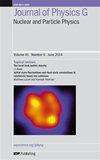239,243Pu同位素电磁偶极子强度的微观计算
IF 3.5
3区 物理与天体物理
Q2 PHYSICS, NUCLEAR
Journal of Physics G: Nuclear and Particle Physics
Pub Date : 2022-11-17
DOI:10.1088/1361-6471/aca3bf
引用次数: 1
摘要
本文首次基于准粒子声子核模型(QPNM)研究了239,243Pu同位素的电偶极子(E1和M1)响应,通过添加残余相互作用来解决平均场方法引起的旋转、平动和伽利略对称性的违反。我们重点研究了E1和M1偶极子强度和光吸收截面,结果表明,巨偶极子共振(GDR)以95%的比例最能描述实验趋势。在Ex= 8-20 MeV处发现了大部分的E1强度,但在Ex= 4-8 MeV处,矮偶极子共振(PDR)的总B(E1)↑强度约为1.83 e2fm2,对应于Thomas-Reiche-Kuhn (TRK)和规则的2%。此外,剪刀模强度低于4 MeV的总B(M1)↑值为5.65,低于奥斯陆数据(10.1(15))。然而,理论预测的剪刀共振结构在1-3.5 MeV能量范围内具有两个峰,与奥斯陆数据中发现的趋势相似。本文章由计算机程序翻译,如有差异,请以英文原文为准。
Microscopic calculation of the electromagnetic dipole strength for 239,243Pu isotopes
This work investigates the electric and magnetic dipole (E1 and M1) responses for 239,243Pu isotopes based on the quasiparticle phonon nuclear model (QPNM) by adding the residual interactions for addressing the violations of rotational, translational, and Galilean symmetries caused by the mean-field approach, for the first time. We focus on the E1 and M1 dipole strengths and photo-absorption cross sections up to 20 MeV, and the results reveal that the giant dipole resonance (GDR) best describes the experimental trend with a ratio of 95%. It appears that most of the E1 strength is found at Ex=8–20 MeV, but the total B(E1)↑ strength for the pygmy dipole resonance (PDR) at Ex=4–8 MeV accounts for some 1.83 e2fm2, which in turn corresponds to 2% of the Thomas–Reiche–Kuhn (TRK) sum rule. Furthermore, the resultant total B(M1)↑ value for the scissors mode strength below 4 MeV is 5.65 , which is lower than that of the Oslo data (10.1(15) ). However, the theoretically predicted scissors resonance structure with two peaks in the 1–3.5 MeV energy range exhibits a similar trend to that found in the Oslo data.
求助全文
通过发布文献求助,成功后即可免费获取论文全文。
去求助
来源期刊
CiteScore
7.60
自引率
5.70%
发文量
105
审稿时长
1 months
期刊介绍:
Journal of Physics G: Nuclear and Particle Physics (JPhysG) publishes articles on theoretical and experimental topics in all areas of nuclear and particle physics, including nuclear and particle astrophysics. The journal welcomes submissions from any interface area between these fields.
All aspects of fundamental nuclear physics research, including:
nuclear forces and few-body systems;
nuclear structure and nuclear reactions;
rare decays and fundamental symmetries;
hadronic physics, lattice QCD;
heavy-ion physics;
hot and dense matter, QCD phase diagram.
All aspects of elementary particle physics research, including:
high-energy particle physics;
neutrino physics;
phenomenology and theory;
beyond standard model physics;
electroweak interactions;
fundamental symmetries.
All aspects of nuclear and particle astrophysics including:
nuclear physics of stars and stellar explosions;
nucleosynthesis;
nuclear equation of state;
astrophysical neutrino physics;
cosmic rays;
dark matter.
JPhysG publishes a variety of article types for the community. As well as high-quality research papers, this includes our prestigious topical review series, focus issues, and the rapid publication of letters.

 求助内容:
求助内容: 应助结果提醒方式:
应助结果提醒方式:


